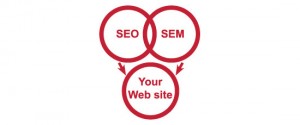The term of SEO or search engine optimization has won its time on the spotlight. SEO is the most important thing a webmaster must consider if wanted to have a high page rank. Next to SEO, there is SEM (Search Engine Marketing) which becoming popular each day. But until now, many people still fail to differentiate between SEO and SEM.
SEO is a component of SEM. Search engine optimization is one of the most cost-effective functions of a search engine marketing campaign, but it is only one element of SEM. The term of SEO means the act of optimizing a website for organic or natural search engine listings While SEM is the act of marketing a website via search engines, whether by improving rank in organic or natural listings, paid or sponsored listings or a combination of both.
A comprehensive search engine marketing campaign includes the following functions:
- Search engine optimization
- Search engine and directory submission management
- Paid inclusion and trusted feed programs
- Pay-for-placement management (includes pay-per-click)
- Link popularity / reputation development
- ROI and performance monitoring and reporting
Now that you know the difference, here are some of the strengths and weaknesses of SEO and SEM.
SEO – PROS
- Organic listings are a trusted source of information, believed to be unbiased and indexed solely by the automated methods of an objective third-party
- Natural search traffic provides a steady stream of traffic over time
- Costs are frontloaded; once pages are optimized for organic search, low ongoing maintenance fees make it cost-efficient for marketers on a limited budget
SEO – CONS
- Organic results can be unfocused in their content and occasionally misconstrued through automation
- There’s little control over which terms your pages will be linked with or how well they get ranked
- Relatively low control over your listing copy – automated technology decides what’s displayed
- Organic listings have to be optimized well in advance of the intended pay-off and require great insight to production efforts down the road
- Engine requirements can be at odds with site design and architecture; it is often difficult to present information that is both accessible to search spiders and carefully designed to influence consumer behavior
For these reasons, it becomes important to actively monitor organic listings and brand rankings within. There is no substitute for a proper SEO program and the natural traffic it provides.
SEM – PROS
- Paid traffic comes with a measure of predictability, allowing marketers to forecast both volume and cost-efficiency for relevant metrics
- The free-market bidding system offers full access to a target audience and the opportunity to scale campaigns and pursue them aggressively, creating synergies with sales promotions
- Paid traffic can provide a boost to site volume when most needed
- Creative is completely customizable, to further the user’s search intent and strategically position a brand within that search engine dialogue
- Paid listings are manually generated, and constructed with more awareness to the environment and a consumer’s true intent
- Sponsored ads are known to drive more sales than ordinary search links, converting at higher rates
SEM – CONS
- Paid listings can get very expensive across competitive keywords, where market forces can quickly inflate cost-per-clicks (CPC)
- A certain portion of the customer base is wary of paid listings.
In conclusion, search engine optimization is simply a component of search engine marketing. They are both important for managing and improving your website. We hope this has cleared up any SEO and SEM confusion.
 Windows Hosting Blog – Seekdotnet.com Blog about Windows Hosting and ASP.NET Hosting
Windows Hosting Blog – Seekdotnet.com Blog about Windows Hosting and ASP.NET Hosting

